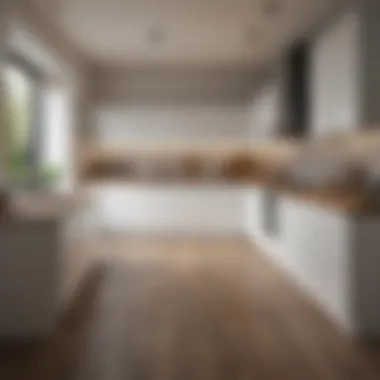Understanding Kitchen Installation Costs and Budgeting


Intro
Understanding the financial implications of a new kitchen installation is crucial for any homeowner looking to remodel. This decision greatly affects the household's overall aesthetic and functionality. Thus, a well-informed approach to budgeting is essential. This article aims to explore the various factors that influence kitchen costs, assisting readers in navigating through the complexity of materials, labor, and design choices.
Homeowners, interior design enthusiasts, and even those who enjoy hosting gatherings often dream of having a kitchen that serves as the core of their homes. However, without a clear understanding of the potential expenditures and variables involved, this dream can quickly become overwhelming.
Design Inspirations
Creating a captivating and functional kitchen requires understanding modern design trends. Homeowners must explore what styles resonate with them while considering cost implications.
Trending Styles
Recent design trends lean towards minimalism and open-concept layouts. Shaker cabinets, for example, are not only visually appealing but also budget-friendly, making them a popular choice. Open shelving systems are also gaining traction, offering an opportunity to display items while providing easier access to frequently used cooking tools.
Other styles that have carved their niche include farmhouse and contemporary. The farmhouse style embodies rustic charm through wood accents and muted colors, whereas contemporary kitchens focus on sleek designs with high-end finishes. Assessing these styles helps set realistic expectations and frame the budget accordingly.
Color Palettes
Color selection plays a significant role in kitchen design. Neutral tones such as whites and grays provide a modern touch and create an illusion of a spacious area. Alternatively, darker shades can often add elegance and depth. Combining contrasting colors can also yield an eye-catching aesthetic, but it’s important to be mindful of how such choices affect overall costs. For instance, painting cabinets in bold hues may increase labor costs if it requires multiple coats or specialized techniques.
Maintenance and Upkeep
Once the kitchen is installed, routine maintenance is required to preserve its appeal and functionality. Understanding routine care can prevent costly repairs and extend the lifespan of installed materials.
Seasonal Maintenance Checklist
- Inspect cabinets and countertops for signs of wear.
- Check plumbing fixtures for leaks or rust.
- Clean appliances such as ovens and refrigerators thoroughly at least once every season.
- Ensure ventilation systems are functioning efficiently.
Following a regular maintenance schedule can result in less frequent renovations, saving funds in the long term.
Cleaning and Organization Tips
A well-organized kitchen not only enhances usability but also plays a vital role in maintaining a tidy appearance.
- Utilize drawer dividers to keep utensils from cluttering.
- Use clear containers to store dry goods, making it easy to keep track of supplies.
- Regularly declutter countertops to avoid accumulating unnecessary items.
These small practices contribute to an ideal cooking environment and can influence future renovations by maintaining the existing structure in excellent condition.
"A clear understanding of projected costs and regular maintenance of the kitchen can lead to maximizing the investment significantly."
Through this exploration, readers can better navigate the complexities of kitchen installations while respecting their financial boundaries. The subsequent sections will delve deeper into specific costs and budget-friendly recommendations for materials and workmanship.
The Initial Considerations in Kitchen Costs
When planning a new kitchen, understanding initial considerations in costs is crucial. This phase lays the foundation for a successful renovation. Homeowners must recognize what objectives they aim to achieve and their specific needs. Clarity in goals can help avoid overspending. It’s important to pinpoint your desires before diving into the details of budgeting and material selection.
Defining Your Kitchen Goals
Defining your kitchen goals is the first step. These goals go beyond aesthetics and functionality. Take time to decide what you want your kitchen to accomplish. Is it a space for family gatherings? Or perhaps a practical area for cooking? Defining these objectives helps shape your renovation project.
Consider the activities you regularly perform in your kitchen. A busy kitchen may need more storage and counter space. Conversely, if you prioritize style over function, you may focus on luxury finishes and trendy designs. This process includes evaluating existing layout and how changes can enhance efficiency.
A detailed list of goals can serve as a blueprint. Share your vision with contractors or designers for better alignment on expectations. Having clear goals also aids in prioritizing budget allocation later in the process.
Setting a Realistic Budget
After establishing your kitchen goals, the next critical step is to set a realistic budget. The relevance of this cannot be overstated. A good budget reflects both your goals and financial capacity. Start by researching average costs in your area. This gives a frame of reference and aids in avoiding unrealistic expectations.


It’s beneficial to categorize expenses into major components. For instance:
- Cabinetry
- Countertops
- Appliances
- Labor
- Finishing touches
Each category may have various price ranges. Identifying where you are willing to splurge or save can streamline your decision-making. Besides primary expenses, don't forget to include unexpected costs in your budget planning. This often-overlooked aspect is vital in a kitchen renovation due to the unpredictable nature of construction work.
Ultimately, the goal is to strike a balance between achieving your dream kitchen and staying on budget. An informed budget provides focus and prevents unnecessary financial strain.
Key takeaway: A successful kitchen renovation begins with clearly defined goals and a realistic budget. Both are integral in guiding decision-making throughout the project.
Key Factors Influencing Kitchen Costs
Understanding kitchen costs is crucial for any homeowner or enthusiast looking to renovate their space. Several key factors contribute to the final expenditure, influencing both the budget and the quality of the kitchen. From material selection to the complexity of the design, each element plays a significant role in determining overall costs. Focusing on these factors allows individuals to make informed decisions, ensuring that their kitchen renovation aligns with both their financial constraints and their ultimate goals.
Material Quality and Selection
The quality of materials directly impacts kitchen costs. Higher-quality materials usually mean better durability and aesthetics, but they also come with a higher price tag. Different materials can range significantly in costs. For example, natural stone countertops like granite can be much more expensive than laminate options. It is essential to evaluate the materials you want for cabinets, countertops, flooring, and fixtures.
Key considerations include:
- Durability: Will the materials withstand daily use over time?
- Aesthetics: Do the materials fit the design vision you have?
- Maintenance: What ongoing costs might be associated with upkeep?
Selecting the right materials requires careful balancing between visual appeal and practicality. Investing in quality can save money in the long run, as replacements or repairs can become costly.
Labor Costs and Hiring Professionals
Labor is another significant factor in the overall cost of a new kitchen. Hiring professionals like contractors, electricians, and plumbers adds to expenses but can ensure a quality installation. Labor costs can vary greatly depending on location, the expertise of the professionals, and the complexity of the project.
When considering labor costs, think about:
- Experience of the contractors: More experienced workers might charge higher rates, but they often deliver superior quality.
- Scope of work: The more complex the project, the higher the likely labor costs.
- Local market rates: Understanding local rates for labor can help in budgeting effectively.
Ensuring a well-planned approach and hiring skilled professionals can prevent costly mistakes throughout the renovation process.
Kitchen Design Complexity
The complexity of the kitchen design is another vital element affecting costs. A simple design with straight lines and fewer features will cost less than an intricate layout that includes islands or built-in appliances. Think about the layout’s functionality and whether it suits your lifestyle. Complex designs including custom cabinetry or unique architectural features may also lead to increased expenses.
Important design considerations include:
- Layout efficiency: How will traffic flow in the space?
- Customized elements: Do you want bespoke solutions, or will standardized options suffice?
- Style coherence: Does your design integrate well with the rest of your home?
Kitchen design is not just about aesthetics; it is about creating a functional space that meets your needs.
In summary, the decision-making process encompasses many elements. Material choices, labor costs, and design complexity are just a few aspects that substantially influence kitchen renovation expenses. Understanding these factors will help ensure that the investment made results in a space that is both beautiful and functional.
Typical Cost Breakdown
Understanding the cost breakdown of a new kitchen is crucial for homeowners and design enthusiasts alike. It offers a transparent look into where funds will be allocated and helps in making informed decisions. The kitchen is often referred to as the heart of the home, and its renovation can be a substantial investment. Knowing the various components and their associated costs allows for effective budgeting and planning.
A typical kitchen remodeling project may comprise several key areas that demand financial consideration. Each element contributes not only to the aesthetic of the kitchen but also to its functionality. Here are the primary cost categories:
Cabinetry and Storage Solutions
Cabinetry forms the backbone of kitchen storage and organization. It significantly impacts both style and functionality. The cost of cabinetry can widely vary based on material, design, and finish. Custom cabinets generally offer more flexibility in terms of style but come at a higher price point.
- Stock Cabinets: These are pre-made and typically the least expensive option. They offer limited designs and sizes but are readily available.
- Semi-Custom Cabinets: Provides options to modify stock options. Slightly more expensive, they strike a balance between affordability and customization.
- Custom Cabinets: Built to your specifications, these can be pricey. However, they allow complete control over every detail, including materials and finishes.
Storage solutions like pull-out shelves, lazy Susans, and built-in organizers can also add to the overall cabinetry cost. Considering both aesthetics and utility is essential in this segment of the budget.


Countertops and Surfaces
The choice of countertops plays a key role in kitchen design and durability. Materials such as granite, quartz, and marble are popular but vary greatly in cost.
- Laminate: Usually the most affordable surface, laminate offers a wide range of designs.
- Granite: Costs can range significantly based on quality and origin. It provides high durability and a timeless look.
- Quartz: Engineered and more consistent in color than natural stones, it often sits between laminate and granite in pricing.
Consideration of the countertop’s durability and maintenance needs is important when deciding. The overall feel and functionality of the kitchen will be influenced by this decision, hence it deserves careful thought.
Appliances and Fixtures
Appliances can either make or break the budget. Higher-end brands oftentimes command a premium price but may offer advanced features and longer warranties.
Key appliances include:
- Refrigerator: Costs depend on size, brand, and energy efficiency.
- Oven and Stove: Options range from basic models to high-end dual-fuel ranges.
- Dishwasher: Energy-efficient and quiet models may cost more initially but can save money in the long run through reduced energy bills.
Fixtures such as sinks and faucets also contribute here. Stainless steel sinks have become almost standard, but other materials can elevate the kitchen's elegance, potentially increasing the costs. Make sure to balance style with functionality and ease of maintenance.
Flooring Options
Flooring choices can dramatically affect both the look and practicality of the kitchen. Whether you opt for tile, hardwood, or vinyl, each material offers unique benefits and challenges.
- Tile: Durable and available in various materials like ceramic or porcelain. Grout lines, however, require maintenance and cleaning.
- Hardwood: Beautiful and warm but not always ideal for a kitchen due to potential water damage unless properly treated.
- Vinyl: Generally the most economical choice, modern vinyl can replicate more expensive materials and is easy to maintain.
Flooring choices should consider not only aesthetics but management of wear and tear in a high-traffic area like the kitchen.
Understanding the typical cost breakdown aids in planning your kitchen renovation wisely. Aiming for a well-distributed budget across all categories ensures a balanced approach to achieving your ideal kitchen. Overall, careful thought in each element reveals the complexity behind what might seem like straightforward choices.
Variances Across Kitchen Styles
Kitchen designs vary significantly, which directly influences their pricing and overall cost structure. Understanding the variances across different kitchen styles is crucial for homeowners or anyone who is planning a renovation. It allows one to make informed decisions that align with both their aesthetic preferences and budget constraints. Each style comes with its unique materials, labor considerations, and design complexities that affect the final expenditure.
Modern Kitchen Costs
Modern kitchens emphasize clean lines, functional layouts, and minimalistic approaches. The cost of a modern kitchen can be higher due to the use of high-quality materials such as quartz countertops or custom cabinetry.
Some key factors influencing costs in modern kitchens include:
- Materials: The use of sleek surfaces and innovative designs can lead to more expensive material choices. Popular materials include stainless steel, glass, and engineered stone, which offer durability and style.
- Technological Integration: Many modern kitchens incorporate smart appliances and integrated technology. These features, while adding convenience, can increase initial costs significantly.
- Labor Costs: Skilled labor for modern designs may demand higher wages. The intricacies in layout and installation require experienced professionals.
Traditional Kitchen Expenses
Traditional kitchens often feature classic designs with warm tones, intricate mouldings, and well-defined styles. Costs associated with traditional kitchens can vary widely based on the materials used and the extent of detail in the design.
Key cost factors include:
- Cabinetry: Often built from high-quality woods and featuring detailed craftsmanship. Custom-built cabinets can greatly drive up costs, as opposed to semi-custom or stock options.
- Countertop Selection: Materials like granite and marble are popular in traditional designs, impacting the overall budget. While they add character, they are also among the pricier options.
- Fixtures: Sinks and faucets that reflect a traditional aesthetic may also contribute significantly to the expenses, depending on their design and brand.
Farmhouse Style Budgeting
Farmhouse-style kitchens evoke a rustic charm, characterized by natural materials and a cozy aesthetic. While this style is generally perceived as budget-friendly, costs can still vary.
Considerations that affect budgeting for farmhouse kitchens include:
- Natural Materials: Using reclaimed wood or natural stone can be economical for those seeking sustainability. However, the cost can increase if sourcing becomes challenging.
- Open Concept Design: Many farmhouse layouts are open plan, which might involve additional expenses related to structural changes, depending on the existing layout of the home.
- Decorative Elements: The style’s emphasis on beadboard, shiplap, and barn doors can enhance visual appeal but may add to renovation costs.
By grasping the nuances within each kitchen style, homeowners can better strategize their budgets, ensuring they meet both aesthetic and functional needs without overspending.


Additional Considerations
When embarking on a kitchen renovation, several meticulous aspects demand attention beyond the direct costs of materials and labor. Understanding these additional considerations ensures a smoother, more predictable renovation process. Homeowners should recognize that planning extends far beyond mere aesthetics and functionality; legalities and hidden expenses can significantly impact the overall budget.
Permits and Legal Fees
Kitchen renovations in many jurisdictions require permits. These are essential for ensuring that the work complies with local building codes and safety regulations. The cost of obtaining permits varies greatly based on location and the scope of work planned. Typically, fees could range from a couple of hundred to several thousand dollars.
Homeowners should begin by checking with their local government to see what specific permits are needed. It may also be wise to consult with a local contractor who is familiar with the requirements. Failing to secure necessary permits could lead to fines, or worse, the need to redo aspects of the project, which adds unplanned financial strain.
Unexpected Costs During Renovation
Renovations often unveil unforeseen expenses. Hidden issues such as plumbing irregularities, electrical problems, or structural damage may surface once demolition begins. These surprises can derail the initial budget and extend timelines.
Planning for unexpected costs is crucial. A recommended practice is to set aside an emergency fund—usually about 10-20% of the total budget. This buffer allows homeowners to handle surprises without significant stress.
"Anticipating hidden costs is often the key to a successful renovation. Being prepared reduces anxiety and keeps the project on track."
Financing Your New Kitchen
When embarking on the journey of a kitchen renovation, financing is a crucial aspect that homeowners must consider. The costs associated with installing a new kitchen can add up quickly, and understanding how you will fund this project is essential for maintaining financial stability. Proper financing allows homeowners to allocate their resources effectively, ensuring that they can achieve their desired kitchen without falling into debt. Moreover, knowing your financing options empowers you to make informed decisions right from the planning stage to the completion of the renovation.
Home Equity Loans and Lines of Credit
Home equity loans and lines of credit are popular choices for many homeowners looking to finance their new kitchens. These options allow you to borrow against the equity you have built up in your home. Equity is the difference between what your home is worth and the amount you owe on your mortgage. Using this equity can be advantageous, as interest rates on these loans are often lower than other types of loans.
- Home Equity Loan: This provides a lump sum of money that you repay over a fixed term at a fixed interest rate. It can be useful for those who prefer a predictable repayment schedule and a one-time amount for significant renovations.
- Home Equity Line of Credit (HELOC): This creates a revolving line of credit you can draw from as needed, making it flexible for ongoing costs or unexpected expenses during your kitchen renovation.
Both options have their pros and cons, and it is vital to understand your financial situation before proceeding. For those considering these alternatives, a credit score and your home’s current value will significantly influence the terms and interest rates offered.
Personal Loans for Home Renovation
Personal loans represent another viable option for financing your new kitchen. Unlike home equity loans, personal loans are unsecured, meaning they do not require you to put your home on the line. This can be especially appealing for homeowners who may not have substantial equity in their properties.
- Fixed Rates: Many personal loans come with fixed interest rates, allowing you to know exactly how much you will pay each month. This certainty can be beneficial when budgeting for a kitchen project.
- Quick Access to Funds: The application process for personal loans tends to be faster than for home equity loans, providing quicker access to funds which can be critical when renovation timelines are tight.
In contrast, personal loans might have higher interest rates than home equity loans, owing to their unsecured nature. Therefore, it is crucial to shop around and find the best deal that fits your financial capacity and renovation costs.
"Proper planning and understanding your financing options can make the difference between a stress-free renovation and a financial burden."
The End: Planning for Your Kitchen Renovation
Planning for a kitchen renovation is essential. This process allows you to align your vision with your financial reality. It also helps to ensure that your goals are achievable. By taking the time to review your budget and designs, you minimize the risk of overspending or facing unexpected obstacles.
Effective planning involves detailed consideration of various elements. From material quality to labor costs, each component plays a significant role in the overall budget. This segment focuses on critical factors that can influence the successful execution of your kitchen project.
Reviewing Your Budget and Plans
Reviewing your budget is a fundamental step. Begin by cross-referencing your initial estimates with quotes received from contractors and suppliers. This will provide clarity on whether your estimated costs align with the market. It is advisable to leave a buffer for unpredictable expenses. Renovations often reveal issues such as plumbing or electrical upgrades that may be necessary but were not initially anticipated.
It is also important to revisit the priorities established at the outset. Ask yourself if the features you desire still align with your budget. If not, adjustments might be necessary.
Key steps to revisit your plans:
- Assess costs: Review invoices and estimates thoroughly.
- Consider alternatives: Don’t hesitate to look for less expensive materials or options that still meet your design vision.
- Check timelines: Ensure your timeline accommodates any revised plans or budgetary constraints.
Tips for Staying Within Budget
Staying within your budget is crucial for every homeowner. Here are some strategies to help manage costs effectively:
- Prioritize essential items: Identify which elements of your renovation are most important and focus your budget on those.
- Shop smart: Explore local outlets, online marketplaces, or second-hand stores for materials. They can often be found at significant discounts.
- Do some work yourself: If you have the skills, consider tackling minor tasks on your own. This could include painting or installation of non-specialized fixtures.
- Monitor progress: Keep an eye on the budget throughout the renovation. Tracking spending helps avoid surprises and allows for adjustments in real-time.
Staying informed about your expenditures helps you maintain control over your project.
By implementing these tips, you can create a kitchen that not only meets your style preferences but also respects your financial constraints. Remember, successful planning and execution demand diligence and attention to detail. After all, a well-thought-out renovation can yield a kitchen that enhances your lifestyle and increases your home's value.







